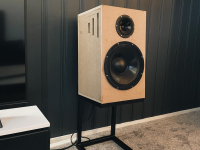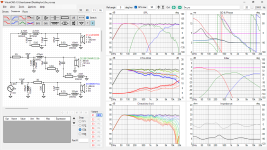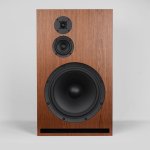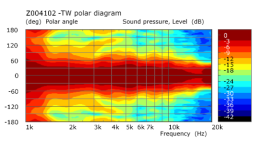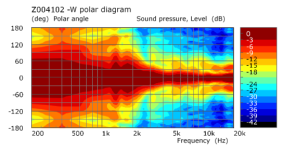Just in case anyone is looking for it: https://www.diyaudio.com/community/...-coax-upper-end-other-uniq-adventures.377221/in MrStitcha's excellent thread
@CinnamonRolls: Sometimes its just all about the looks of the speaker.. 😉
It doesn't look like the traditional simian sarcophagus so it isn't appropriate for the project. What I'm curious about is once you're on a flat surface like this and can't use a waveguide does the coaxial outperform a SB26STAC or the SB26ADC/CDC?
I suspect a waveguide designed for a flat baffle would outperform the coaxial but I was wondering about constraints in a budget/simplicity build. It's almost 50% less expensive for the drive units, not sure if it causes an increase in passive crossover components that offset that because I don't know anything about passive crossovers.
Your previous coaxial project (and proposal) is better but if you're constrained by a casket (no cardioid allowed) is the coaxial better or worse than tweeter over mid? That earlier simulation threw me off because the directivity got bumped up like we'd expect from a coaxial. Also, you have to remember I'm stupid and miss simple things other people see so if people are rolling their eyes at me I understand. 😄
Attachments
Funny I has the same idea with Sica coax this morning 🙂 My choice will be 6,5" to match 12" better. Imho good fit to sls12 with bucking magnet. My concern is consistency - had few of them in my hands and some had different polepiece, some had not so good tweeter to cone area, ...
Here's the Sica 6,5"
I'm not able to read the data and interpret how it would perform on a flat square edged baffle. The only reason I could with the 5,5" was because Sigberg placed measurements on Spinorama.org. 6.5" does sound like it might be even better. Or the 8 inch 8 C 2 CP with the compression driver + removing the plastic horn and replacing it with a custom insert but that's going way off the reservation. Sort of. In a certain respect maybe. Are monkey boxes intended to be party boxes? If so, then an eight inch with a compression driver in the center over a 12 inch sounds like a party to me.
Attachments
Sica 5.5 and 6.5 are better off in a very narrow enclosure due to the curved profile of the basket/surround. Could work with an external waveguide-like flange, though
I don't understand the effect of a curved diaphragm and what enclosure works best with it, however, how does it compare to tweeter over mid on a flat Old School Monkey Casket. Yes, it's not the best use of a coaxial but I'm trying to understand it in the context of this style of speaker.
The SB26ADC/CDC/STAC perform well on the newer high performance enclosures. Which also tend to be narrow. They also perform better with waveguides. But the retro party box style is flat surface with square edges. Especially if you want it budget and easy to build (no expensive router bits, etc.)
The SB26ADC/CDC/STAC perform well on the newer high performance enclosures. Which also tend to be narrow. They also perform better with waveguides. But the retro party box style is flat surface with square edges. Especially if you want it budget and easy to build (no expensive router bits, etc.)
as we move further and further away from the original ‘3-way in a short vented box’ concept, it’s going to sound different
And as it starts to look more different, it’s going to sound different.
If you like the classic look better, then it IS better

A Future Classic is a different project.
And as it starts to look more different, it’s going to sound different.
If you like the classic look better, then it IS better
A Future Classic is a different project.
So the takeaway is...people who have a nostalgic feeling towards the vintage 3-way "look" are going to build this and think it looks really good... And even more so since people also have a preference for something they make themselves...and therefore will think it sounds really good. Thus, all of our decisions on drivers, cabinet construction, and crossover don't really matter because they are already predetermined to sound great!! 😁😁😁
She might have a sweet voice regardless whether you can see her or not.
If she looks great, her voice will sound even sweeter to your ears...
Designers, proceed to do your best design, given the constraints.
DIYers, proceed to build your best cabinet, given your individual constraints.
If she looks great, her voice will sound even sweeter to your ears...
Designers, proceed to do your best design, given the constraints.
DIYers, proceed to build your best cabinet, given your individual constraints.
Last edited:
For me it would not be that, a wide baffle speaker sounds different than slim tower speakers (that are done a million times now probally). But it's out of fashion it seems, and only slim towers with waveguides are accepted here if i see how this tread goes.So the takeaway is...people who have a nostalgic feeling towards the vintage 3-way "look" are going to build this and think it looks really good... And even more so since people also have a preference for something they make themselves...and therefore will think it sounds really good. Thus, all of our decisions on drivers, cabinet construction, and crossover don't really matter because they are already predetermined to sound great!! 😁😁😁
I'm not in the market for such a speaker now (i got to many other projects) but i find it interesting because of it's something different and i know that kind of speakers can sound very good (i heared some very good examples). But speaker fashion rules point that you are not allowed to build this it seems, which is sad... And then they wonder why i don't post much of my own projects. It's because of that.
It is unfortunate that you feel this way. I have never felt any pressure to build or not build any kind of speaker, especially on this forum. This forum seems to enthusiastically support new design/build efforts for everything from large open baffle dipoles, to multiple-entry-horn (MEH) systems, and everything in between. Of course there will always be nit-wits and curmudgeons who criticize anything and everything... Don't let small people get in the way of big things... .... j.But speaker fashion rules point that you are not allowed to build this it seems, which is sad... And then they wonder why i don't post much of my own projects. It's because of that.
So I have some rough measurements, hopefully they are useful.
5 inch Midranges: Scanspeak 15W/4434G00, SB Acoustics SB15MFC30-08, Markaudio CHP-90. Only the SS is 4-ohm.
Tweeters: SB Acoustics SB26STAC and SB26ADC, and Peerless XT25BG60-4
Here is the mock-up baffle with the SB26STAC and SS 15W/4434 and a 12" circle (the exact size of a Lowe's bucket). There is about a 1/16th inch gap between the inserts and the baffle, but these were covered in masking tape.

The side walls were made with cardboard and stapled to an MDF frame and I had a small opening in the back to run the wires. I think more rear energy from the midrange came through than I had anticipated so I'm only reporting 0 to 100 degrees in 20-degree increments, as the 120+ angles looked weird to me. Also, somehow I messed up of the 20-degree measurements on two of the tweeters, so the tweeters show 0, 40, 60, 80, 100 degrees.

Midranges on-axis

THD

Distortion at 86dB/1m and 96dB/1m (taken at 96dB and 106dB at 31.5cm)
CHP-90


15W/4434


SB15MFC30-8


TWEETERS

Tweeters On-axis

THD

Distortion at 86dB and 96dB
SB26ADC


SB26STAC


XT25BG60


5 inch Midranges: Scanspeak 15W/4434G00, SB Acoustics SB15MFC30-08, Markaudio CHP-90. Only the SS is 4-ohm.
Tweeters: SB Acoustics SB26STAC and SB26ADC, and Peerless XT25BG60-4
Here is the mock-up baffle with the SB26STAC and SS 15W/4434 and a 12" circle (the exact size of a Lowe's bucket). There is about a 1/16th inch gap between the inserts and the baffle, but these were covered in masking tape.
The side walls were made with cardboard and stapled to an MDF frame and I had a small opening in the back to run the wires. I think more rear energy from the midrange came through than I had anticipated so I'm only reporting 0 to 100 degrees in 20-degree increments, as the 120+ angles looked weird to me. Also, somehow I messed up of the 20-degree measurements on two of the tweeters, so the tweeters show 0, 40, 60, 80, 100 degrees.
Midranges on-axis
THD
Distortion at 86dB/1m and 96dB/1m (taken at 96dB and 106dB at 31.5cm)
CHP-90
15W/4434
SB15MFC30-8
TWEETERS
Tweeters On-axis
THD
Distortion at 86dB and 96dB
SB26ADC
SB26STAC
XT25BG60
to me the SB15MFC can be supressed from the list because the huge break ups for passive filter. The peak from the SSv15W disco at 1k5 is a little disapointing... can be a little reduced by off seting the driver from the center on the baffle. however still below what is before so no harming I surmise ?
I'm not sure the SB15MFC's breakups are too much to handle - they peak at 6kHz. But I look forward to comments/discussion.
The dips (for all drivers) at 1.5kHz are exactly what was modeled on a wide baffle earlier by someone. We can discuss pro's and con's of offset drivers later, but here is a 5" midrange centered and offset:
Centered:

Offset:

The dips (for all drivers) at 1.5kHz are exactly what was modeled on a wide baffle earlier by someone. We can discuss pro's and con's of offset drivers later, but here is a 5" midrange centered and offset:
Centered:
Offset:
Anyone who's done these will know that it takes hours just to generate a data for a few lines. So thank you for presenting them.
The placement of the midrange at this positions really wreaks havoc on the smooth response that these drivers would usually have when measured on a large baffle/2pi like the manufacturer's datasheet?
The only alternatives that I see, are a) putting interchanging the tweeter with the mid ie. MTW instead of TMW, or b) off-setting the mid and tweeter to one side.
I really under-estimated the appeal of the 3-way monkey boxes. It seems everyone is getting in on the action:
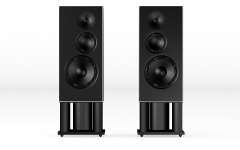
I mean, what's next, a Dynaco A25 reboot (10" + 1.3" 2-way) ?
The placement of the midrange at this positions really wreaks havoc on the smooth response that these drivers would usually have when measured on a large baffle/2pi like the manufacturer's datasheet?
The only alternatives that I see, are a) putting interchanging the tweeter with the mid ie. MTW instead of TMW, or b) off-setting the mid and tweeter to one side.
I really under-estimated the appeal of the 3-way monkey boxes. It seems everyone is getting in on the action:

I mean, what's next, a Dynaco A25 reboot (10" + 1.3" 2-way) ?
On the other hand, if you think about it, even ideal drivers can't do better than say +/-3db on such baffle due to diffraction, and what it means sound is different to all observation angles, which means there is only one good observation angle so head in vice type of thing at worst. Sound very likely benefits from room treatment that reduce early reflections, because all of them have different spectra. Whether the diffraction matters or not depends on individual whether they hear it in their application and mind about it more than looks. It just sets ceiling on the performance, such box is not optimal but actually quite mediocre as acoustic construct. Still, it looks good, and is quite easy to build, and perhaps not too bad of a sound for most, so it has nice appeal. Higher aspect ratio of the baffle, offset drivers and usage of waveguide help it some. Biggest motivation for such project in my opinion is to have fun, and pretty good outcome and accept the response is what it is. If someone is looking for top performance, consider acoustically better shape, no need to agonize and fight against physics 🙂
Last edited:
....
I mean, what's next, a Dynaco A25 reboot (10" + 1.3" 2-way) ?
That's been here for some time now.
https://www.seas.no/index.php?optio...eas-a26-kit&catid=66:seas-diy-kits&Itemid=345
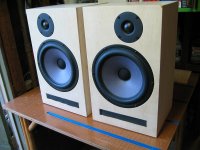
Finally finished these! Check out the build here. Will connect some of my FW amps after I get used to things. Sounding nice so far.
BK
BK
Last edited:
- Home
- Loudspeakers
- Multi-Way
- Budget Classic 3-way Discussion Thread
